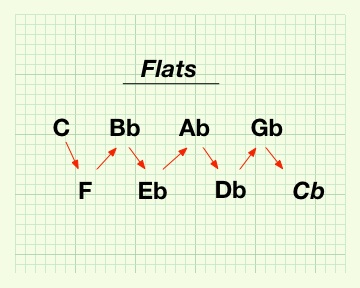Flatten It Out
by D.S.
(Italia)

Flattened Circle of Fifths - Sharps
From the beginning, using the circle of fifths chart was always difficult. In my mind, it was tough to picture it, manipulate it, learn from it- so I flattened it out.
**Note: I wrote this using the major scale only, but you can write in the minors if you like.
It looks like this:
Sharps (#)
C D E F#
G A B C#
Explanation: The top line starts at C, always, then goes one whole step up. You mark the sharps based on where that note lands on the piano (either on a white or black key). The bottom line starts at five notes up (including C), then goes one whole step up as well. Mark the sharps on the bottom line the same way as the top.
Flats (b)
C Bb Ab Gb
F Eb Db Cb
Explanation: Start at C, go one whole step down, marking the flats based again on the piano. The bottom line starts at five notes down (including C), then goes one whole step down each time from there. Mark the flats on the bottom line the same way as the top.
For conversation purposes, I separated both scales into two lines, but you can integrate the rows just as easily with no problems.
As for numbering sharps and flats, it works the same way as in the circle: first note has no sharps/ flats, last note has seven. Then, using those numbers, figure out what is marked using FCGDAEB for sharps, and BEADGCF for flats.
Comments for Flatten It Out
|
||
|
||
|
||
|
||
Hope this helps! Practice hard and let me know if you have any questions!


